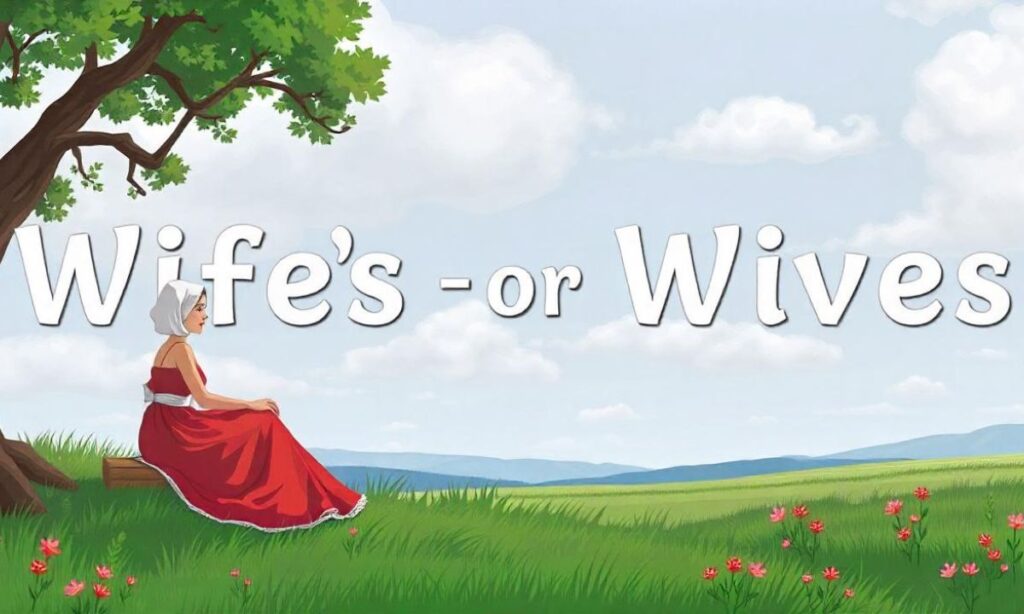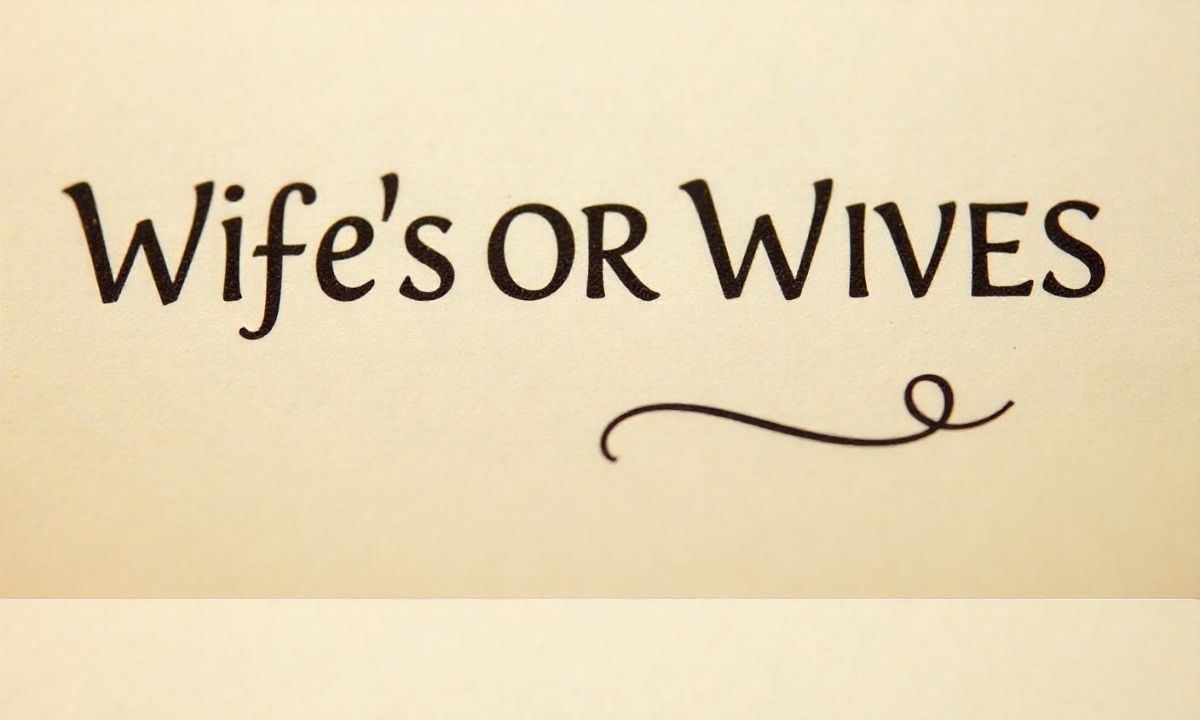Navigating the nuances of possessive forms can trip up even seasoned writers. Whether you’re drafting a legal document, writing a novel, or sending a professional email, understanding the difference between “wife’s” and “wives'” isn’t just about grammar – it’s about clear communication and professional credibility.
Singular Possessive: The Case of Wife’s
When referring to something belonging to one wife, we use “wife’s.” This singular possessive form shows individual ownership by adding an apostrophe and ‘s’ to the singular noun “wife.” Think of the apostrophe as a little flag marking possession.
Example Scenario:
“My wife’s car needs repairs.” Here, we’re talking about a car belonging to one wife. Let’s explore more contexts:
- “The wife’s testimony proved crucial in the case.”
- “His wife’s cooking always impresses dinner guests.”
- “The wife’s signature appeared on all important documents.”
Plural Possessive: The Case of Wives’
When multiple wives possess something (perhaps in a historical or cultural context), we use “wives’.” First, the word becomes plural (wives), then we add an apostrophe after the ‘s’ to show possession.
Example Scenario:
In discussing historical polygamous societies: “The wives’ quarters were in separate buildings.” Notice how this indicates spaces belonging to multiple wives. Consider these examples:
- “The wives’ collective decision influenced the community.”
- “All the wives’ contributions were acknowledged.”
- “The wives’ rights varied across different cultures.”
Apostrophe Rules and Common Pitfalls
Apostrophes trip up many writers because they serve two different functions: showing possession and creating contractions. For possession, the basic rule is simple – add ‘s to show something belongs to one person or thing.
For plural possessives, add just an apostrophe after the s. Watch out for irregular plurals like children’s and people’s, which need ‘s even though they’re plural.
Singular Possessive Nouns
Key Rules:
- Add ‘s to singular nouns: dog’s bone
- Add ‘s to singular nouns ending in s: James’s book
- Add ‘s to irregular plurals: children’s toys
Plural Possessive Nouns
Remember:
- Add only an apostrophe to regular plural nouns ending in s: dogs’ bones
- Add ‘s to irregular plurals not ending in s: people’s rights
Understanding Possession and How It Relates to Wife’s and Wives’

Think of possession as a relationship between things. Wife’s shows one wife owns something: “my wife’s car.” Wives’ means multiple wives own something: “the wives’ book club.”
The apostrophe acts like a little arrow pointing to who owns what. Once you grasp this relationship concept, the rules become more intuitive than mechanical.
The concept of possession in English extends beyond mere ownership. It can indicate:
- Physical possession
- Relationship connections
- Attributes or characteristics
- Temporal associations
Possessive Forms in Sentences
Consider these professional contexts:
Correct: The wife’s attorney filed the motion.
Incorrect: The wives attorney filed the motion.
Correct: The wives’ attorneys represented them separately.
The Importance of Apostrophe Usage in Professional Writing
In professional settings, proper apostrophe usage signals attention to detail and education level. Mistakes like “the companies success” instead of “the company’s success” can make you look careless or unprofessional.
This matters especially in legal documents, business proposals, and formal correspondence where precision is crucial.
Professional credibility often hinges on proper grammar usage. In formal writing, apostrophe errors can undermine your message’s authority.
Example Scenario (Legal Document):
“The wife’s property rights shall remain protected under Section 3.2 of this agreement.”
| Context | Correct Form | Incorrect Form |
| Single ownership | wife’s property | wives property |
| Multiple ownership | wives’ properties | wives’s properties |
| Joint ownership | wives’ shared account | wives’s shared account |
Grammar Tools and Writing Exercises to Master Apostrophe Usage
Modern technology offers many ways to check your apostrophe usage. Grammar checkers catch obvious errors, but don’t rely on them completely.
The best approach combines tools with practice exercises. Try writing sentences about ownership and then check them against reliable style guides. Create your own examples using singular and plural possessives in different contexts.
Recommended Tools:
- Grammarly
- ProWritingAid
- Hemingway Editor
- Microsoft Editor
- Google Docs’ grammar checker
Mastering Possessive Forms for Language Mastery
True mastery comes from understanding rather than memorizing rules. Read your writing aloud – does the possession make sense? Who owns what? Practice with real-world scenarios like writing emails about team projects or describing family relationships.
Start simple and gradually tackle more complex cases like joint possession (“Tom and Jerry’s adventures”) or nested possession (“my friend’s sister’s car”).
Practice Exercise: Complete these sentences:
- The _____ (wife/wives) decision was final.
- The _____ (wife/wives) opinions varied greatly.
- The _____ (wife/wives) lawyer presented new evidence.
Example Scenario (Professional Email):
Subject: Update on Wife’s Benefits Package
Dear HR Team,
I need to update my wife’s healthcare coverage. Could you please send the relevant forms?
Best regards,
John
Example Scenario (Fiction Writing):
“Sarah watched as her neighbor’s wife’s garden bloomed with spring flowers. The other wives’ gardens paled in comparison.”
Table: Key Differences Between Singular and Plural Possessive Forms
| Form | Usage | Example | Common Mistake | Quick Tip |
| Wife’s | Single ownership | wife’s car | wives car | Think “one wife owns” |
| Wives’ | Multiple ownership | wives’ cars | wives’s cars | Think “multiple wives own” |
Wife’s Vs Wives
The key difference lies in number and possession. “Wife’s” refers to one wife who owns something, while “wives” is simply the plural form without possession. Think of “wife’s” like pointing to one person’s belongings: “my wife’s phone.” The word “wives” comes up when talking about multiple spouses:
“all the wives gathered for lunch.” Many writers mix these up because they sound similar, but keeping track of whether you’re talking about one or many makes the choice clear.
Wife Possessive Form
When showing something belongs to a wife, add ‘s to create “wife’s.” This follows the basic rule for making singular nouns possessive. Here’s what makes it simple: start with “wife,” add an apostrophe and s, and you’re done. For example:
- “The wife’s opinion matters most”
- “My wife’s family lives nearby”
- “The wife’s career took off last year”
The possessive form “wife’s” works in any context where you’re showing ownership, relationship, or connection to one wife.
Wives In Possessive Form
For multiple wives (plural possessive), first make “wife” plural to get “wives,” then add an apostrophe after the s. This becomes “wives'” – notice the apostrophe comes after the s. You’ll see this in historical contexts, cultural discussions, or when referring to multiple marriages:
- “The wives’ collective decision”
- “The wives’ responsibilities varied by culture”
- “All the wives’ children played together”
Remember: the apostrophe goes at the end because it’s a plural possessive. If you’re writing about something belonging to multiple wives, the apostrophe follows the s that makes “wife” plural.
Conclusion
Mastering the distinction between “wife’s” and “wives'” strengthens your writing and professional communication. Remember:
- “Wife’s” shows one wife possessing something
- “Wives'” indicates possession by multiple wives
- Context determines which form to use
- When in doubt, ask yourself: “How many wives are involved?”
Practice these rules regularly, and you’ll find your grammar confidence growing with each use.
Note: Grammar tools mentioned should be verified for current availability and features.

